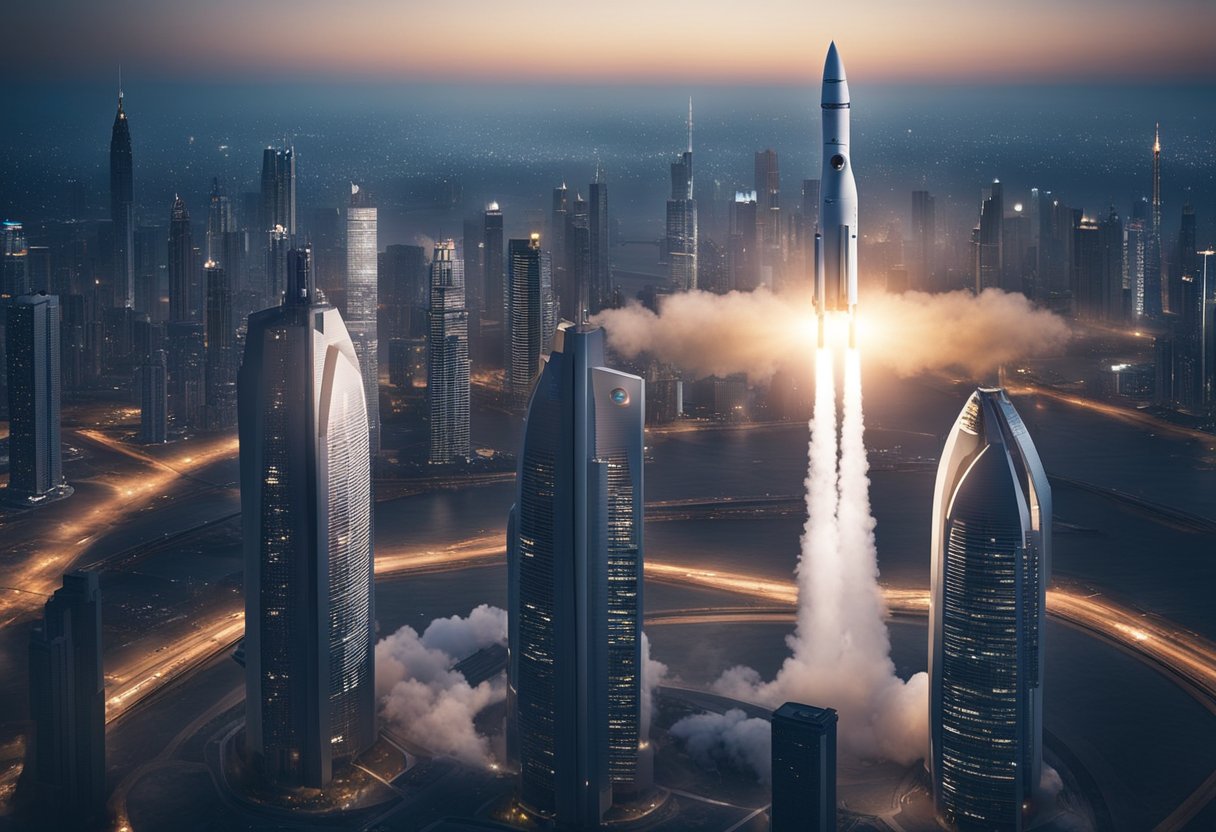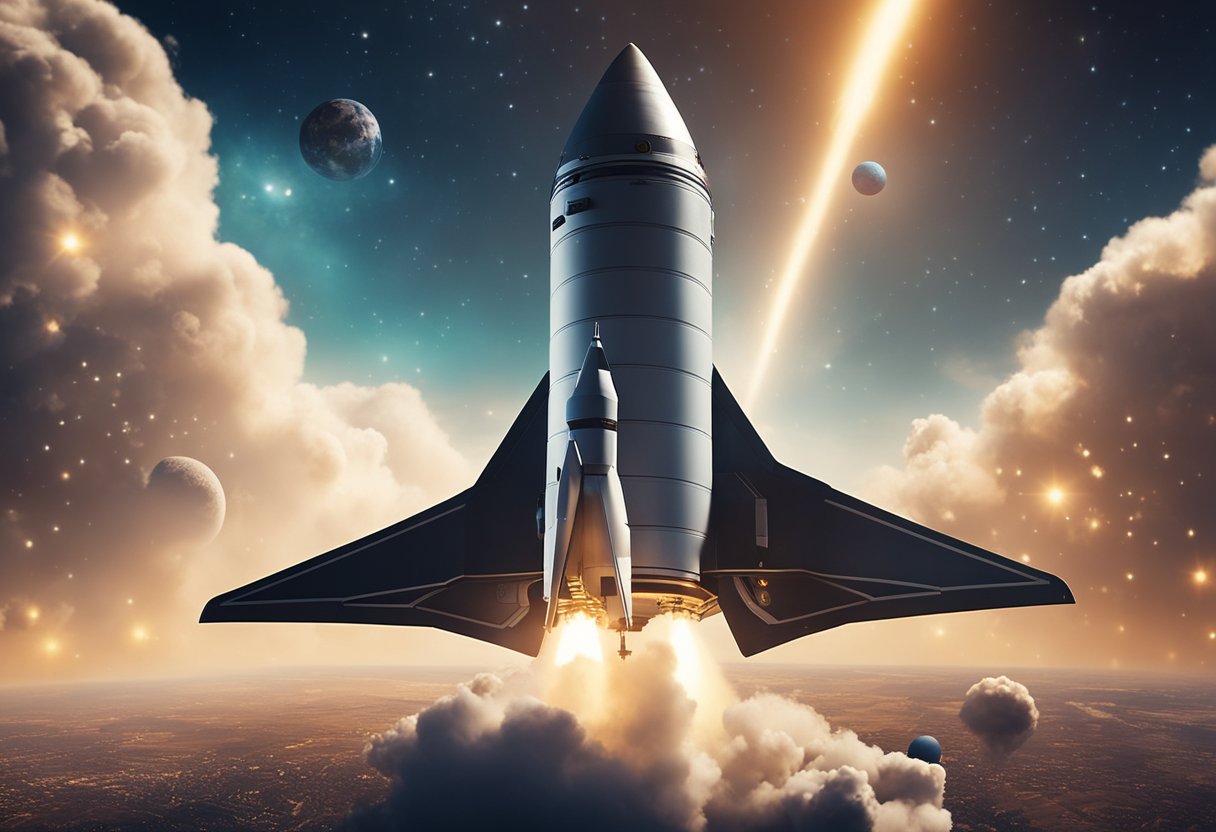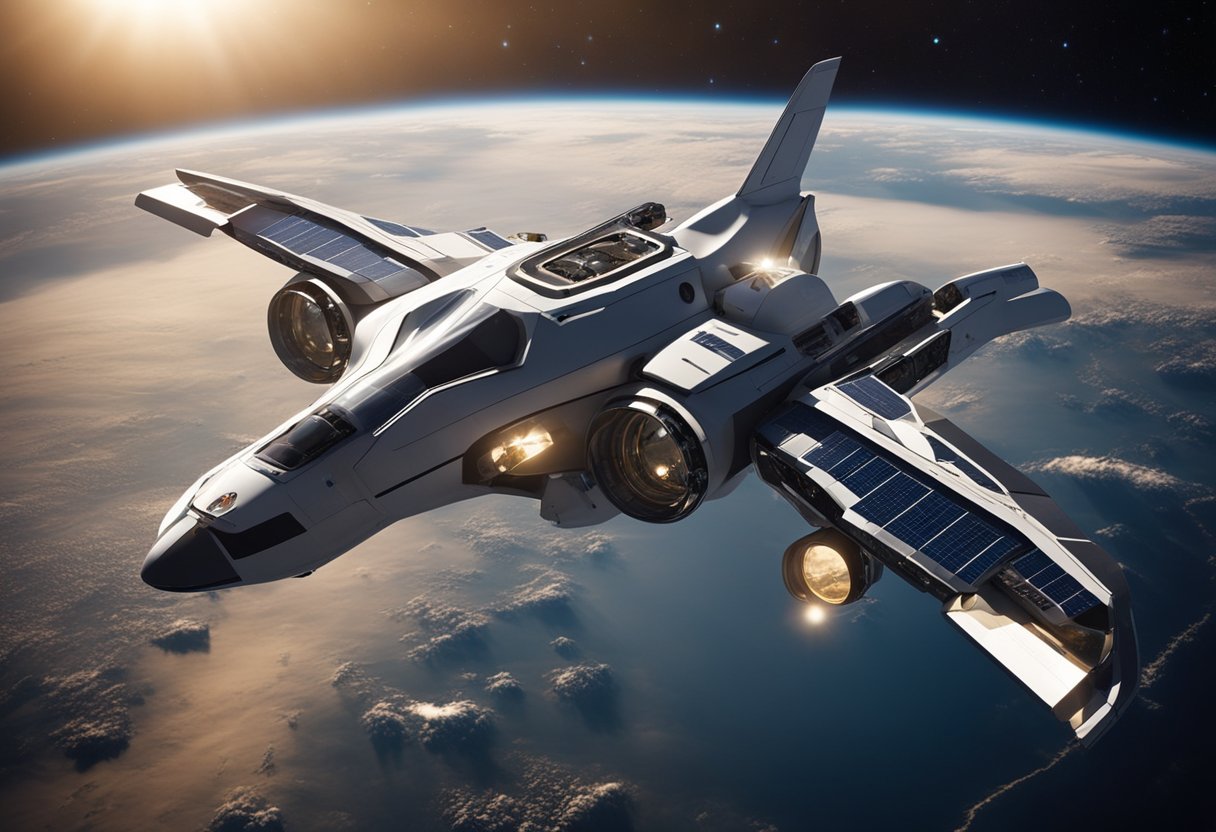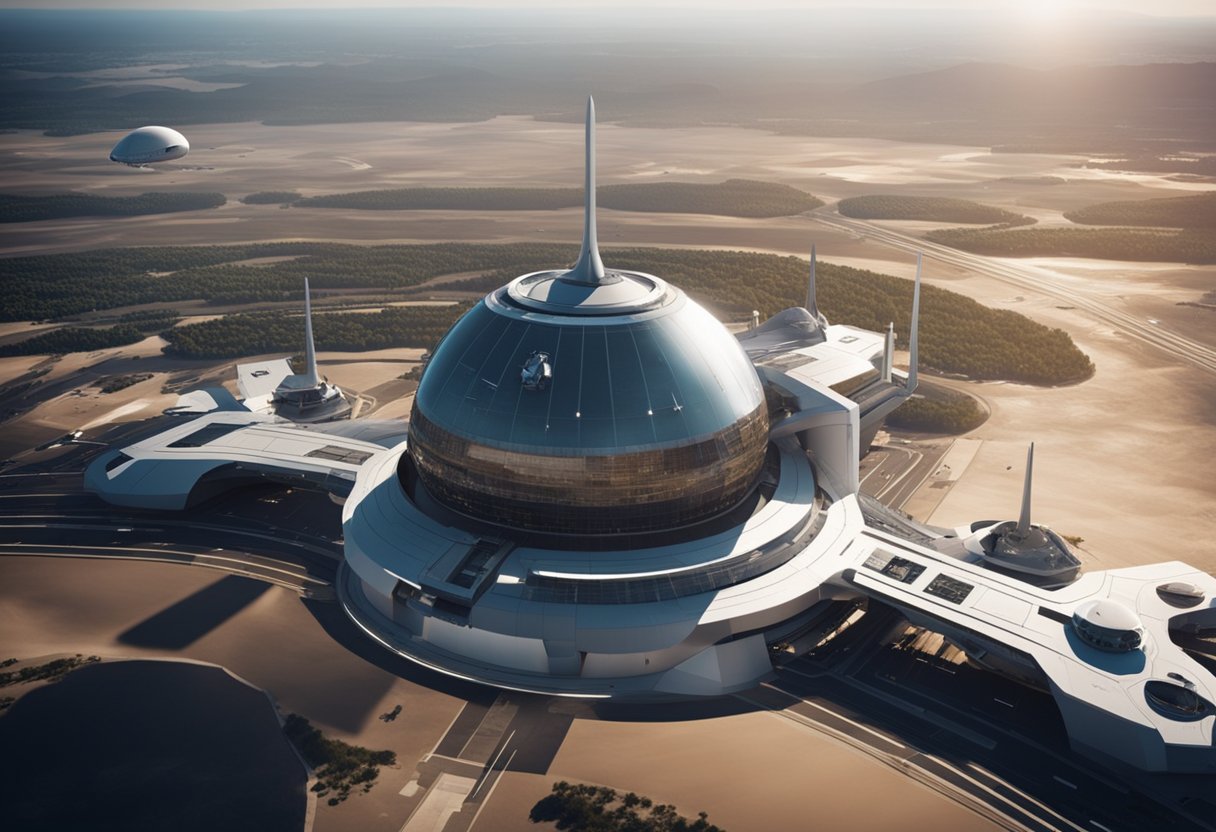
Space tourism, once a futuristic fantasy, is becoming an exciting reality. As we enter a new era of exploration, private companies and international space agencies are turning the dreams of intergalactic travel into tangible experiences.
With advanced spacecraft and technologies, the opportunity for a voyage beyond Earth’s atmosphere is opening up to more than just professional astronauts. Today, we stand on the cusp of a new frontier where tourism blends with the cosmos, offering unprecedented adventures for those seeking the ultimate escape.

Indeed, space tourism promises an unparalleled journey, inviting the curious and the brave to witness the magnificence of space firsthand. The growing interest has sparked the development of significant spaceports around the world and has begun to shape the infrastructure necessary for routine space excursions.
As we consider the cultural impact of space exploration and its legal and ethical considerations, we also acknowledge our role in ensuring a responsible future for interplanetary travel. We are at the threshold of a new chapter in human achievement, and the possibilities for exploration and discovery are as limitless as space itself.
Space tourism has moved from a speculative fantasy to a tangible reality, marking significant milestones and attracting heavyweight industry contenders eager to turn orbital trips into a mainstream commodity.
The unforgettable moment when Yuri Gagarin orbited Earth in 1961 ignited humankind’s venture into space tourism, with that same spirit later seeing Neil Armstrong take humanity’s first steps on the Moon. However, it wasn’t until 2001 that Dennis Tito made history as the first space tourist, underlining a new era where not just astronauts, but also private individuals could experience space.
In the vanguard of the space tourism industry are companies like Virgin Galactic, spearheaded by Richard Branson, and Blue Origin, founded by Jeff Bezos. Both firms have successfully launched their founders into suborbital space, heralding the onset of commercial space travel.
SpaceX, led by visionary Elon Musk, has not only sent astronauts to the International Space Station (ISS) but is also eyeing tourist missions further afield, with ambitious plans for Mars. Other industry players look towards a future where space hotels and lunar vacations are a reality, as documented on early websites such as SpaceVoyageVentures.com.
Our relentless pursuit of space exploration reflects our innate desire to expand our frontiers and share the wonders of the cosmos with the wider public.
In this section, we’re exploring the remarkable advancements in spacecraft design and the rigorous safety measures and training programmes developed to prepare tourists for the experience of space travel.
The quest for space tourism has spurred exceptional innovations in spacecraft design. High-profile entities such as Virgin Galactic’s SpaceShipTwo and SpaceX’s Crew Dragon have been pivotal in demonstrating how commercial spaceflight can become accessible and somewhat routine.
Blue Origin’s New Shepard suborbital vehicle has also made significant strides, offering passengers brief excursions into space with a capsule designed to provide large windows for breathtaking views of Earth. Our collective effort in the aerospace community is also reflected in Boeing’s Starliner, which reflects a leap forward in making extended stays in space possible for future tourists.
Ensuring the safety of space tourists is our utmost priority. Each individual partaking in a space journey must undergo comprehensive training covering the physical and psychological challenges of spaceflight. This involves familiarisation with the craft’s technology, emergency procedures, and simulating the unique experience of microgravity.
Another layer of safety is the technological sophistication of the rockets themselves, which are equipped with fail-safes and redundancies to handle a variety of scenarios.
For those looking further into the breakthroughs and experiences of space tourism, SpaceVoyageVentures.com serves as a repository of current and future space tourism opportunities, chronicling the journey from early conceptual stages to the tangible experiences now within our reach.
As space tourism evolves, intriguing destinations are becoming accessible that promise unique experiences like weightlessness and breathtaking views of Earth. We explore these destinations and the opportunities they offer for high-flying travellers.
The International Space Station (ISS), a marvel of international cooperation and engineering, offers the quintessential space experience. Through companies like Axiom Space, we may soon be able to visit the ISS, a destination that for decades has been reserved for professional astronauts.
Here, aside from the surreal experience of weightlessness, one can relish the unparalleled views of Earth’s curvature and witness the splendour of auroras from a vantage point like no other.
Private space stations are next on the horizon, with ambitious projects such as Orion Span, planning to offer luxury space hotel accommodations. Though in its nascent stages, the notion of private space habitats opens up the possibility for longer stays in orbit, catering to those who dream of becoming temporary denizens of the cosmos.
For those of us seeking a shorter journey, suborbital space flights present an enticing alternative. Companies such as Blue Origin are developing experiences that catapult passengers just past the Kármán line, the recognised boundary between Earth’s atmosphere and outer space.
Participants will experience several minutes of weightlessness and gaze upon the incredible vista of our planet surrounded by the inky vacuum of space. Flights departing from facilities like the Baikonur Cosmodrome add historical significance to the journey, as this site has been a portal to the stars since the dawn of the space age.
Our understanding of these emerging space tourism opportunities is bolstered by resources like SpaceVoyageVentures.com, where the promise of space travel is well-documented. Whether it’s a voyage to the ISS or a suborbital sojourn, the prospects for space tourism are rapidly taking shape.
As we venture into the age of space tourism, there are pivotal aspects potential space tourists must address, specifically regarding the necessary training and meeting the financial requisites of this exclusive experience.
Before embarking on a journey beyond Earth’s atmosphere, we require comprehensive training designed to acquaint us with the unique conditions of space travel. Launch procedures, for example, demand an understanding of the spacecraft’s operations and emergency protocols.
As a space tourist, we must also condition our bodies to cope with the different altitude levels and the microgravity of space. Our training typically includes sessions in centrifuges to simulate launch conditions, swimming in neutral buoyancy pools to mimic weightlessness, and detailed safety briefings.
The prospect of becoming a space tourist is an exhilarating one, yet it is currently accessible to a limited few due to the high costs involved. Booking a trip to space requires not only a significant financial investment but also access to the agencies that arrange these extraordinary tours.
Ticket prices to suborbital space can range from hundreds of thousands to millions of pounds, making economic accessibility one of the chief barriers for many enthusiasts.
Our efforts to make space tourism safe and delivering a culturally enriching experience remain at the forefront. New developments in space tourism are continually transforming the map of accessible destinations beyond our planet.

In the burgeoning era of space tourism, a few notable launch sites stand as pillars of this adventure-fuelled frontier. Here, we discuss significant spaceports that are not only gateways to the cosmos but also historic landmarks in humanity’s celestial journey.
Spaceport America, situated in the desert terrains of New Mexico, has become a symbol of commercial space exploration and tourism. As the world’s first purpose-built commercial spaceport, it is home to Virgin Galactic’s suborbital flights, offering a new era of space tourism.
The facility boasts a futuristic design and aims to serve as a hub for space industry innovation. Our adventure into the stars begins here, where passengers will embark on journeys that were once the stuff of science fiction.
Adjacent to the clear blue Floridian skies, the Kennedy Space Center has been an iconic venue for aerospace exploits. Since the dawn of the Space Age, it has served as a launch site for pivotal missions that have pushed the boundaries of what is possible.
Another remarkable site—one that captivates both space and Earth science enthusiasts—is the Very Large Array in New Mexico, an astronomical observatory that explores cosmic phenomena. While distinct from a traditional spaceport, this array plays a vital role in our understanding of the cosmos.
We invite you to explore these destinations not only as spectators but as participants in the next chapter of space exploration. Whether attending a launch at Kennedy Space Center or gearing up for a spaceflight at Spaceport America, we’re at the cusp of a new age of travel where the stars are finally within our reach. For those intrigued by space tourism opportunities on the horizon, SpaceVoyageVentures.com provides a glimpse into this exciting future.

Space travel offers a unique combination of exhilarating sensations and visual spectacles. Journeying beyond Earth’s atmosphere, we are privy to experiences that alter our physical state and offer breathtaking perspectives on our planet and the cosmos.
Once we break free from Earth’s gravity, our bodies encounter microgravity, where the sensation of weightlessness takes over. This is not the absence of gravity but rather the feeling of perpetual free fall. Adapting to this environment means relearning everyday actions; even simple tasks like eating and moving require a different approach. The International Space Station (ISS) gives us an insight into this, showcasing astronauts conducting research and living in these unique conditions.
From the portholes of spacecraft, we’re greeted by views unattainable on Earth. The view of our home planet, encapsulated in a serene blue sphere, floating against the infinite blackness of space, is profound.
While on a space tourism mission, we might witness the aurora borealis—the Northern Lights—dancing across Earth’s magnetic fields, an ethereal spectacle usually observed from polar regions. Every glimpse outwards is a moment etched in the annals of personal history, encapsulating the essence of our pioneering spirit in the final frontier.

As we chart the celestial course for humanity’s expansion beyond Earth, two significant focal points emerge: Mars and the prospects of space settlements.
Mars, often referred to as the Red Planet, stands as the current pinnacle of our interplanetary travel ambitions. Our future missions aim not only to set foot on Martian soil but to establish a permanent presence. Advances in propulsion technology and life support systems are in development to make the journey to Mars more feasible. As documented by SpaceVoyageVentures.com, trips to Mars could transition from aspirational odysseys to tangible options for scientific and, eventually, civilian explorers.
Space settlement represents the next quantum leap in space exploration, where we envision self-sustaining habitats beyond Earth. Mars serves as the most viable candidate for these settlements, due to its relative proximity and the presence of resources like water ice.
Space agencies and private entities are already outlining plans for habitats that could support scientific communities and, in the long term, larger civilian populations. Furthermore, the allure of encountering the distinct landscapes of planets like Saturn and Neptune ignites our imagination, but these remain in the realm of future prospects due to their harsh environments and the current limitations of space travel technology.

As we examine the burgeoning field of space tourism, it’s imperative that we address the legal and ethical frameworks underpinning this adventure into the final frontier. Our journey into orbit is not just technological but also enters realms regulated by international law and ethical prerogatives.
Understanding Regulatory Frameworks is fundamental in grounding the new era of human spaceflight. Space Adventures and similar firms must navigate a maze of international agreements and national laws. The Outer Space Treaty, to which nations like Russia (home to Roscosmos) are signatories, governs activities in outer space, including the International Space Station (ISS). With companies offering trips to the ISS or even potential orbiting hotels, ensuring compliance with these regulations is paramount.
We must grapple with the Environmental Impact of Space Tourism. Launching rockets introduces pollutants into the atmosphere and poses potential harm to the stratosphere. As we endeavour to make space tourism a part of our legacy, we hold the ethical responsibility to minimise our ecological footprint and protect the outer space environment.
By addressing these legal and ethical considerations with attentiveness and foresight, we can achieve a balance between the quest for cosmic exploration and the imperatives of safeguarding our environment and adhering to international laws. SpaceVoyageVentures.com details various opportunities, whilst highlighting the importance of responsible stewardship in this final frontier.

In highlighting the significance of space exploration, we observe its profound impact on media and entertainment, as well as its ability to inspire future pioneers in the space industry.
Space exploration has profoundly influenced media and entertainment. From films to television series and books, the feats of missions like Apollo 11 have been a source of constant fascination. Films such as ‘The Right Stuff’ and ‘Apollo 13’ offer dramatised retellings of space explorations that have captivated global audiences, and massively successful franchises like Star Trek and Star Wars may not have existed without the cultural backdrop of space exploration.
Documentaries that encompass the intricacies of Mission Control and the experiences of astronauts further enrich our popular culture.
We find that the legacy of space exploration is especially potent in motivating young minds to reach for the stars, metaphorically and literally. Educational initiatives benefit substantially from the historic achievements of Apollo 11, as the mission serves as a benchmark for human ingenuity and perseverance.
Companies like Space Perspective are not only pushing the envelope by developing new space tourism opportunities but are also cultivating a culture that sees space as a realm of possibility. This is evident on platforms such as SpaceVoyageVentures.com, which documents the emerging domain of space tourism, offering a glimpse into current and future celestial endeavours.
Through these avenues, we are shaping a generation that values science, technology, engineering, and mathematics, driving them towards innovative futures.

Private entities are pivotal in the burgeoning field of space tourism, providing innovative solutions and partnerships to turn the dream of space travel into reality for more individuals.
In recent years, companies such as Virgin Galactic, led by Richard Branson, and Blue Origin, driven by Jeff Bezos, have emerged as frontrunners in the commercial space tourism sector. Both aim to make space accessible to non-astronauts, positioning themselves as pioneers in this industry.
Virgin Galactic has been working on the SpaceShipTwo, a suborbital spaceplane, while Blue Origin has developed the New Shepard rocket system, designed for a vertical takeoff and landing. Our interest in such enterprises grows as they edge closer to facilitating consumer space travel.
SpaceX, under the visionary guidance of Elon Musk, is taking a slightly different approach, focusing on the prospect of not just space tourism but also on potential interplanetary travel. Although SpaceX initially concentrated on launching satellites and partnering with national space agencies, it is now developing the Starship spacecraft, which aims to offer trips around the Moon – a venture that once seemed the stuff of science fiction.
Moreover, newer platforms like SpaceVoyageVentures.com are already envisaging the spectrum of future space tourism, offering a repository for information on present and forthcoming space tourism experiences.
Collaboration is at the heart of our progress toward space tourism. Private companies have proved that partnerships with established national agencies can accelerate our journey to the stars. For instance, SpaceX has successfully collaborated with NASA to send astronauts to the International Space Station (ISS) aboard its Crew Dragon capsule. This synergy serves as a beacon for growing space tourism, showcasing what can be achieved when private innovation underpins government-backed space exploration.
Collaborations are not limited to personnel transport; they also include plans for space habitats and potential tourism infrastructure. Through such partnerships, enterprises like SpaceX not only assist agencies in reducing costs but also gain valuable insight and lay down the foundational work for their broader tourism ambitions.
In alignment with British English standards, our continued monitoring and analysis reflect an unwavering commitment to providing clear and accurate reporting on the evolving narrative of private companies in space tourism.

In reflecting upon space tourism, we observe a blend of groundbreaking achievements and sobering lessons. Our journey can be traced back to visionary milestones, such as Apollo 11, the first manned mission to land on the Moon. This monumental event ignited the imagination of countless individuals about the potential of space travel.
Alas, the journey through space has not been without its tragedies. The Challenger shuttle disaster of 1986 remains a stark reminder of the risks involved in space exploration. It reinforced the critical importance of safety measures in all aerospace endeavours, becoming a lesson for future tourism ventures.
Roswell, New Mexico, renowned for the Roswell UFO incident of 1947, has sparked a continuing fascination with the possibility of extraterrestrial life and space travel. While the incident remains shrouded in mystery, it has nonetheless played a role in attracting tourists to space-related sites.
White Sands, New Mexico, often celebrated for its natural beauty, holds a special place in the history of space tourism. It serves as a testing ground for spacecraft and potentially, a future launch site for commercial spaceflights.
We acknowledge the New Mexico Museum of Space History as a repository of space heritage, educating visitors on the chronicles of space travel and inspiring a new generation of space enthusiasts.
We take pride in our nascent website, SpaceVoyageVentures.com, which catalogues the evolution of space tourism from mere dreams to tangible experiences. We document the current and forthcoming ventures that promise to extend the frontiers of tourism beyond our planet.
Key Historical Locations:
In this section, we’re answering the top queries about space tourism, including how to get involved and what to expect from this incredible experience.
Currently, suborbital flights offered by companies like Virgin Galactic are the primary destinations for space tourism. Though not destinations in the traditional sense, these flights provide passengers with a few minutes of weightlessness and panoramic views of Earth.
Civilians can book their experiences through space tourism companies that provide suborbital flights. Interested participants must also undergo a series of physical and health assessments, along with basic spaceflight training before their journey.
Yes, it’s now feasible for non-astronauts to experience space. With the advent of commercial spaceflight, companies are making it possible to send civilians to space with only brief, necessary training on safety procedures and acclimation to G-forces.
Space tourism packages typically include the experience of weightlessness, a chance to see the Earth’s curvature, and sometimes even participation in scientific experiments. These packages offer a unique glimpse into the life of an astronaut, albeit for a much shorter duration.
Investing in a space travel holiday can require a substantial financial commitment, typically ranging from hundreds of thousands to millions of pounds, depending on the provider and the duration of the experience.
While still emerging, space tourism is becoming more viable with recent developments. Several companies have made successful test flights, suggesting that commercial trips for the public could become a regular occurrence in the near future.